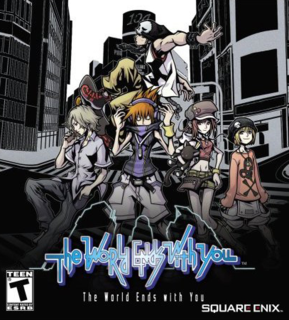[IMPORT]There has never been such an awkward mix of quirky, stylish, and challenging gameplay as It's a Wonderful World.
First things first. When you're looking to import any game in a language you're not fluent or familiar with, you're always wondering if you'll be able to play it. For most games, tough, it isn't a problem, but the genre of RPGs, being very text-heavy, is one of the most in-import-friendly pile to choose from. Unfortunately, IAWW is an RPG, and it does have alot of text, mainly to describe equipment, items, and progress the story. That isn't to say it isn't playable. Square Enix is a popular company, no doubt, and with that popularity comes a rabid fanbase, and so, with enough research, you'll be able to learn the basics of the game with little problem, from equipment to story progression to item effects.
One of the most interesting aspects of IAWW is it's visual style. When the game was first announced as being made by the Kingdom Hearts: COM team, many were turned off by the idea of another 2D game, because of the puzzling hate towards their previous game. Make no mistake, IAWW is 2D, using sprites for characters and attacks. But the characters moving in the "overworld" of Tokyo have 4 animations - Up, Down, Left, and Right - and so, it does give the 'illusion' of being a 3D game. What helps this is the superb quality of the sprites, especially in battles. Not only are the character models well-animated, but the attacks are amazingly well-drawn and fluid. It gives a sort of 'modern-day Okami' vibe (minus the wolf) when unleashing certain attacks, because of their great art direction and animation. The backdrops of these battles are also very well done. There is a strange 'twisting' of the background which gives the effect of the camera looking up onto a huge building or what have you in the background, which is very nostalgic to gamers of the 16-bit era, where bosses were often portrayed as huge beasts in the background, towering over the player. Another nice presentation aspect of its visual style is the game's cutscenes. These are all done via moving images and are all very fluid with the game's way of presenting the story.
One of the other areas in IAWW that will keep you interested is its soundtrack. The game uses many MP3s and sounds that really add to the atmosphere of you being in the bustling city of Tokyo with your headphones on. There is alot of J-pop in the game, and even though I am not a fan of pop, much less j-pop, I enjoyed the music since it matched up with the game's setting so well. There are a few sound bits here and there in some of the story sequences, and they help develop some of the characters' reactions and such. Sadly, full voice over isn't here, but the game takes up a 128 MB cart, the largest available for the time of its release.
However, all previously mentioned points pale in comparison to IAWW's most compelling area - the gameplay. Utilizing the 'slide-cross battle system', you will burn, electrocute, and throw your enemies using the stylus. If that was all there was to it, though, then IAWW would just be a stylish watered-down version of Ninja Gaiden. That is where the top screen comes into play. The super geniuses over at Squeenix decided to allow control of two players at a time, one with the stylus, the other with the D-Pad. If this sounds hectic, that's because it is. You share the same enemies but on different screens. This leads to some interesting strategies, especially on boss battles. Also noteworthy is the fact both characters share the same health bar, which means you can never just leave one character to die while keeping up with your main one. Neku, the main character, uses badges to use skills, such as pyrokinesis, telekinesis, and lightning. You can upgrade your abilities by buying new clothes and items from shops, which all the more adds to the atmosphere of being in Tokyo.
All in all, IAWW is not for everyone. The story is not easily understood unless you read up on it. Also, Neku's movement during battle sequences can be frustrating, since you must first place your stylus directly on him before dragging it to where you want him to go. There is also quite a steep learning curve, as after the 'first day' (The game consists of 7), you're great friend the health bar is introduced, and you will quickly realize how precious health can drain away so fast. Still, with that said, IAWW succeeds in what it was meant to be. There has never been such an awkward mix of quirky, stylish, and challenging gameplay as It's a Wonderful World.

